Leadership Project: Increasing African American's Reading Comprehension using Depth and Complexity and Academic Conversations
Overview
To disrupt barriers and improve teaching practices that currently impedes the academic achievement of African American students in the area of reading comprehension and put practices and strategies in place that accelerates the achievement of SEL’s.
Introduction
“ALL students are highly capable of becoming critical thinking problem solving individuals if given tools and strategies that allows them to access their funds of knowledge and use their cultural experiences to connect to the curriculum thus providing/yielding optimum educational trajectories.” ~Tammi Howard
Failure to develop literacy skills for African American students in elementary schools contributes to the historical perpetuation of socio-economic, racial, and ethnic inequalities experienced in middle school, high school, and life. Therefore, I propose a project that will attempt to disrupt barriers impeding the academic achievement of African American students grades four and five by developing literacy skills targeting specifically reading comprehension inclusive of writing, speaking, and listening skills. The focus will be on the meeting rigorous demands of Common Core State Standards by using Culturally Responsive Practices inclusive of Academic Conversations. In addition when engaging in answering text dependent questions, students will respond to complex text with evidence based answers using thinking tools (Depth and Complexity). The goal is to close the achievement gap by providing students with strategies or a set of tools allowing them to interact critically with text in a way that deepens their understanding and provides them the ability to discuss it with others in a meaningful way.
My leadership project is an improvement plan focusing on improving the educational outcomes for African American (AA) students in the area of reading comprehension. The project will focus on a small sample group. I also believe engaging in this journey will deepen teachers’ pedagogical knowledge about teaching African American students. In addition, it will set out to produce differences relative to historical norms that are visible, positive, and sustainable over time.
I chose this topic to bring awareness to the educators at my school that AA students are highly capable of becoming critical thinking problem solving individuals if given tools and strategies to address their funds of knowledge and cultural differences that improves their educational trajectories. Furthermore, I want to engage educators in methodological practices that speak to the various learning styles of African American students; while focusing on the closing of the achievement in reading comprehension. Based on our school’s Single Plan for Student Achievement data summary sheet, African American subgroup declined from 33% proficient and advance in 2012 to 26% in 2013 in reading comprehension. 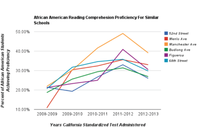
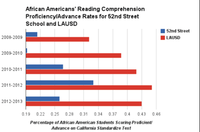
The teams of teachers and other stakeholders are ethnically diverse and are highly interested in examining methodologies and strategies that speak to closing the achievement gap for African American students by developing their literacy skills. Ms. E. Barbee, the content expert, is National Board Certificated Teacher with a certificate in Literacy. She is a former classroom teacher and currently Title III Coordinator and Common Core ELA facilitator/expert at Fifty-Second Street School. Her role, in this improvement plan is to provide support in aligning the Common Core Standards with Culturally and Linguistically Responsive and Relevant Practices, or CLRRP, academic conversations, and depth and complexity. Ms. P. Rowe is a National Board Certificated teacher. She has a certificate in Middle Childhood Generalist. Ms. Guillory and myself are veteran teachers. Ms. Guerrero is in her first year of teaching. All team members will lend their knowledge in analyzing formative data and engage in collaborative practices in which we revise, record, and implement measurable outcomes.
Leadership
My leadership role within this project was to:
1. Attend and actively participate in ongoing training on the reading process, Depth and Complexity, and Academic Conversations. Attend Gifted Institute (where Depth and Complexity in urban settings was highlighted by Dr. Sandra Kaplan) and examined how to implement visual icons to facilitate thinking. Observe exemplary implementation and teaching “non-gifted classes, in various classes at a different school site, where teachers have successfully implemented Depth and complexity in their classroom to facilitate thinking.
2. Implement the reading process inclusive of depth and complexity icons and academic conversations. The reading process is an interactive, problem-solving process of making meaning from texts using visual icons and academic conversations. This pedagogy naturally lends itself to developing foundational reading skills, reading comprehension skills, and analytical skills which are shaped by the reader’s prior knowledge and experiences, the reader’s knowledge about reading and writing language and the reader’s language community which is culturally and socially situated.
3. Support my Mainstream English Language Development (MELD) team in implementing culturally responsive practices/strategies, the reading process inclusive of depth and complexity icon usage, and academic conversations (hand signals) during our morning meld block. Sharing the reading process document with team members and explaining the thinking and the purpose of each section. Lead my team in planning instruction/activities and writing prompts together. Facilitate a discussion around our findings, what students did, and our next steps. Support teachers in understanding and using practices and strategies meeting the needs of Standard English Learners in reading comprehension. Support teachers in understanding the Common Core State Standards for Reading Language Arts; specifically Reading Comprehension.
4. Conduct action-research that answers the question: “How can we develop literacy skills targeting specifically reading comprehension inclusive of writing, speaking, and listening skills that meets the rigorous demands of Common Core State Standards using Culturally Responsive Practices inclusive of Academic Conversations for African American Students.”
5. Lead teachers in collecting, organizing, and analyzing, and evaluating data to determine next steps.
6. Co-facilitate interactive parent meetings in which partnerships are forged, data and strategies are shared, and take home materials are provided to aide help the teachers to build literacy skills.
PDSA Cycle
African American students (AAs) are highly capable of becoming critical thinking problem solving individuals if given tools and strategies to address their funds of knowledge and cultural differences. Within my area focus area, I am specifically interested in tools and strategies suggested to help increase the academic achievement for AAs in developing literacy specifically in the area of reading comprehension. Much of the research points to the attainment of academic achievement in reading comprehension through the usage of CLRRP that validates usage of AAs’ cultural knowledge base, performance styles, prior experiences, and/or frames of references when engaging in academic discourse. Moreover, studies also suggest the construction and articulation of new knowledge be supported with “icons” or visual prompts to develop critical/stronger thinking skills, better content acquisition, and encourage scholarly behavior and language. Most studies emphasized the importance of student conversations in the classroom as critical in fostering academic success. Research also points to the role of the teacher as a facilitator who fosters an environment in which relationships are cultivated, various cultures and language are valued, and students feel safe to take academic risk. It has been found that a teacher who welcomes meaningful fluid equitable relationships, facilitates and embraces student collaboration, provide thinking and speaking tools, and accepts/ validates the culture of students has created an environment in which critical thinking problems solving individuals flourish.
These findings, only reaffirms my hypothesis that when teachers use CLRRP to engage students and provide them with tools to think and speak enhances their ability to comprehend. At my school site in our perspective classes, my team and I currently use academic conversations and depth and complexity icons as tools to support and engage students in thinking critically about various types of texts, across disciplines, and the world around them. Their thoughts are then supported and facilitated by the usage of academic conversation icons as they build on or challenge one’s ideas, support statements with evidence or examples, ask for or provide clarifying remarks, paraphrase one’s words, or synthesize information. With this model in place we have witnessed, the emergence of “scholarly behavior” as well as an increase in reading comprehension. However, I found these same tools have not yielded the expected outcome for the AA subgroup. Infusing CRRLP creates a space of inclusion and accept and respect students’ large knowledge base. It also welcomes them into a learning community that is often exclusionary in practice.
My Logic Model and PDSA Cycle outlines the problem I am trying to address, assumptions, activities, and anticipated results of the action-research project.
Changes and Challenges
The two challenges I faced were the heavy emphasis being place on the interim Smarter Balanced Assessment Consortium (SBAC), or the practice test and scheduling time for members to meet as a team. The lessons for the project was being taught in the morning during our hour Mainstream English Language Development (MELD) block. The district decided to test all the wireless capacity at the school sites and as well as “get students use” to the new state testing format by making it mandatory for schools to participate in interim testing. The interim testing occurred during our MELD block which impacted the completion of of third cycle of our PDSA.
The biggest challenges during this process was the meeting of team members all at the same time. All of the members, including myself, with the exception of the Title III Coordinator/Common Core Expert are classroom teachers. We all felt passionately about the project and its purpose wanted to be a part of the process.; but with commitments made to the school site (Adjunct duties, SSC, Testing Coordinator, Gate Coordinator, Social Committee, Awards Meeting, Grade Level Planning) not to mention family commitments it made the meeting and the collaboration process difficult. The option of meeting during our recess and lunch break was not viable either because the times were different for fourth and fifth grade. When we were not able to meet as a whole group, we turned to technology communicating via email and google chat. There was a lot of sharing and updates that occurred in the hallways. Ideals and successes were shared and noted in passing. If anyone was missing, I personally visited them or sent out an email recapping or sharing information about a topic discussed and getting feedback.
As a result of personal and school commitments and the limited time we were able to meet in person a change was made in the planning process. There was already framework in place that focused on the reading process at our school. The reading process teaches and focus students on the habits of great reader and their actions in developing their reading comprehension skills. In keeping with the ideal of the original proposal, as a school leader I collaborated with the Common Core Expert to see how we could modify the reading process to meet the needs of African American students. We collectively decided it would be best to take students through the entire process but analyzing the “during” and “after” reading section to develop students’ comprehension skills. Before I could effective lead teachers in this process, I had to deepen my own knowledge around this idea. Therefore, I took the existing framework and created lessons inclusive of culturally responsive literature and strategies and opportunities to fortify language through the usage of depth and complexity and academic conversations hand gestures and shared them with the Common Core Expert to ensure they were Common Core aligned. The lessons were then shared with team members for review and feedback before implementation.
Data
I collected interview data from the Mainstream English Language Development teachers, reflection from students, teacher created assessment results and benchmark dibels assessment to inform us on how well CLR literature and strategies/practices, usage of depth and complexity icons, academic conversations, and the reading process were working to improve the academic achievement and enjoyment in reading for African American students. The overall results promising and showed that using culturally responsive literature and strategies, depth and complexity icons to cultivate thinking, academic conversations icons to facilitate language, provided access points, and increase their love of reading.
Analysis of Data
The four other teachers and Common Core Expert that participated in the Action Research Project were very cooperative and helped with the collection, creation, and analysis of data. The Common Core Expert provided input in designing the framework and the teacher created assessments. Using their expertise, teachers also help create assessments, provide authentic feedback as to what they found successful and what needed tweaking or adding during the implementation of the lesson. When all the data was collected, the MELD teachers and I came to the conclusion, based on the results of the data, that the infusion of CLRRP strategies, depth and complexity icons, and academic conversations in reading improved students enjoyment and the success of our students in reading comprehension.
Our team understood that mastery of foundational reading skills preceeds comprehension. So, we used Dibels to establish a baseline data by assessing students fluency rate and the ability to retell which are key in developing comprehension.

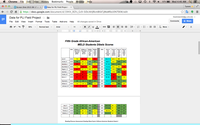

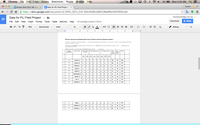
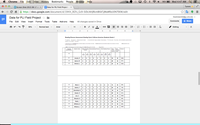

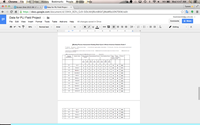
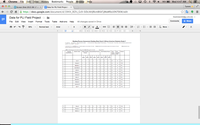
Benchmark and Teacher Created Assessments
In December, we obtain baseline fluency and retell,or reading comprehension using DIBELs. It revealed 9 out of 15 fifth grade students’ fluency rate was below the middle of the year goal of 120 wpm and 6 out of 13 fourth grade students’ fluency rate was below the middle of the year goal of 103 wmp. At the end of the two six week cycles, all 28 students made fluency gains ranging from an increase of 2 words per minute to 34 words per minute. In addition, 3 out of the 15 fourth and fifth grade students who were below grade level fluency reach the end of the year benchmark goals. This data tool also allowed us to see growth in students reading comprehension skills. At the middle of the year, 12 out of the 15 fifth grade students’ and 7 out 13 fourth grade students’ reading comprehension skills were below grade level. After the two four week cycles, all students made gains in reading comprehension and 14 out of the 28 students in total reach reading comprehension end of the year benchmarks for their perspective grade level.
Our two four week cycles focused on reading comprehension skills inclusive of key ideas, making connections, summarizing, theme. A scale of 1 to 4 was used to assess each section. A one meant the student “ little or no statements are evidenced based and or does not connect to the text” to a four “all statements are explicitly clear, evidence based, and connects to the text . The teacher created assessments revealed overall gains in all areas in both grades combined. As note by the chart below.
Teacher Interviews and Anectdotal Notes
Throughout the cycles teachers recorded reading behaviors and statements that were not typically reflected or often missed when students are assessed. The information was shared during check-ins, walks to pick up students in the morning, or during our formal meetings.
Mrs. Rowe shared how her students became engrossed in both selections “The Pudding Like the Night of the Sea” and “Catalog Cats” and really tuned in to the author’s intention usage of similes and metaphors. She also shared how her class engaged in a discussion around appropriate punishment because of what the character experienced in the story. Her student M. Johnson, who lives with his mother and step-dad, expressed to her how lucky the characters were to have their “real dad”. Mrs. Rowe reassured him that his step-dad was super lucky to have a stepson like him and that his dad is the one missing out. From a teacher impact standpoint, Mrs. Rowe expressed how in the beginning of the process she “could not wrap her brain around” the reading process as it was established at our school but through the support she received throughout the cycles, she gain a greater understanding which allowed her to delivered in a more effective efficient manner. Lastly, she expressed that the culturally relevant literature was the catalyst that drove these cycles because students were to able to connect culturally with the story even though it contained an enormous amount of figurative language.
Mrs. Guerrero shared how J. Abrams, B. Lee, and J. Hamilton, who are challenging individuals, were focused during the meld block. They willingly participated in classroom discussions often making connections from text to text and form text to self. She, like Ms. Rowe, began to fully understand the purpose of the reading process as attending to what natural readers do. The verbal and written support she received from other team members and myself allowed her to strenghten her knowledge base so she could efficiently teach it to her students.
Ms. Guillory added how she initially thought the literature was “too easy” for her students but soon learned, after having many conversations, with team members and seeing how engrossed her students were during our lesson block time. She noticed how her students were able to interact with the text and look closer at the author’s intent or the intent of the character because text complexity was not an issue. In the end, she understood the rigor of a lesson lies in the conversations and using depth and complexity icons and academic language to dig deeper. Lastly, Ms. Guillory was beginning to see the skills students learned during our meld time in to other curricula areas.
Student Reflections
At the end of each day, students were asked to reflect about and assess their learning by beginning a statement with “Today I learned…”. Some of the statements are as follow:
“Today I learned about features of a story” ~William B. 4th Grade
“Today I learned about the word about the word “booming” and similes and metaphors ~J. Haywood 5th Grade
“Today I learned that using reading process sheet is basically for the same thing you do when
read a book for example we do the before reading process every time we read a book”. ~D. Lias
“Today I learned you can analyze a text by picking out the most important details.” ~K. Acosta
~4th Grade
Students began to understand the academic language to articulate their ideas about what they learned. In addition they were able to understand the purpose of the reading process as being a tool to help organize their thoughts and ideas so they can comprehend what they are reading. In connecting this process to something the do, the selection of books they read for fun, students were are to make connections to how they choose books they read for pleasure and compare how we address academic text or stories read in class.
After the end of the school year, all of the teachers had a formal meeting in which reflected on areas potential changes to enhance the lessons. We all agreed on incorporating multiple methods of outputs addressing multiple intelligences to show understanding of the end tasks as oppose to have it in written form. We also thought about creating a unit study around a chapter book instead of using sections of chapters books. Our rationale became many of our students are not exposed to chapter books from beginning to end because many of the story we use come from our anthology which is a compilation of sections from various books.
We also review what we thought was the root cause of the underachievement of African American students in reading comprehension and found our word to support our analysis. When students are provided lesson with CRL literature, thinking tools to facilitate critical thinking skills and support in learning to engage in academic conversations, they will begin to dig deeper and foster their reading comprehension skills.
Reflection
As I reflect back on this journey, I think from my perspective my vision and mission was driven by data and made transparent to all participants. Before moving forward, I had to understand and be clear about what that path would look like. I took on the role as the learner first, working closely with the Common Core Expert to ensure that the lessons planned focused on skills connected to the development of reading comprehension skills. In the past, I planned, with other colleagues prior to this and we would divide the work up but I felt I was still missing something in my understanding. So with the guidance of the Common Core Expert, I engage in the arduous process on my own and then share the plans with the team. I was flexible in the implementation process and received constant almost daily feedback from teachers about the implementation and changes for the next story or next school year. In addition, I felt we were experiencing success because of the level of support provided. I ensured all necessary materials required was at their disposal when needed. As a leader, I feel the only way we were going to fail is to not be prepared, supported, or not to be open to critical feedback from team members. It was my job to do just that as well as be open and flexible to constructive feedback.
CAPEs Addressed
CAPE 4:Sharing leadership with others in the school community to help accomplish the vision by collaborating and planning with the Common Core Expert to increase Comprehension Skills for African American Students which is in Direct Alignment with the School's Single Plan for Student Achievement
CAPE 5:Promoting implementation of K-12 standards, pedagogical skills effective instructional practices and student assessment for content instruction by designing standard based lessons for students to increase reading comprehension skills using depth and complexity, academic conversations, CRL literature, and the reading process.
CAPE 6:Evaluating, analyzing, and providing feedback on the effectiveness of classroom instruction to promote student learning and teacher professional growth by collectively and collaboratively using the feedback from team members to enhance praxis for the betterment of the children being targeted.
CAPE 7:Demonstrate understanding of the school and community context by using research based methodologies when designing lesson that meets the needs of African American Students.
CAPE 8:Communicating with the school community about outcomes by sharing data with school leaders along with practices found useful in yielding such results.
CAPE 10:Implementing change strategies based on current, relevant theories and best practices in school improvement by researching theories, best pedagogical practices, and methodologies maximizing educational trajectories. As a team, using the information to drive our instruction.
CAPE 13:Modeling life-long learning and job-related professional growth by researching and learning best practices for addressing the needs of African American Students.
CAPE 14:Helping teachers improve their individual professional practice through by collaborating with my team members and supporting them in the implementation of the lesson cycle based on the needs of their students.
CAPE 20:By facilitating and presenting at Literacy night and teaching parents how they can best support their child at home.
Data Collection: Dibels and Reading Process Assessment Grid
Pre and Post Student Reflections
Students' Reading Process Documents
Students' Text Dependent Questions
Students' Culminating Assignment

